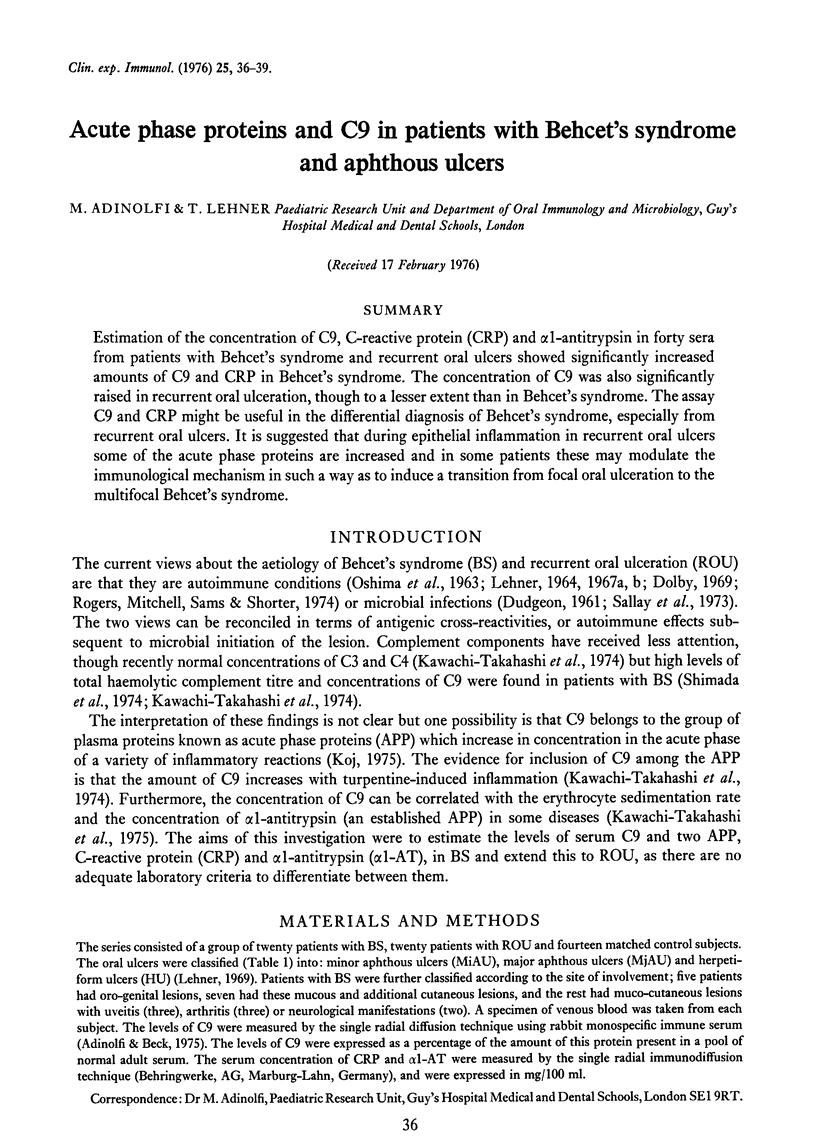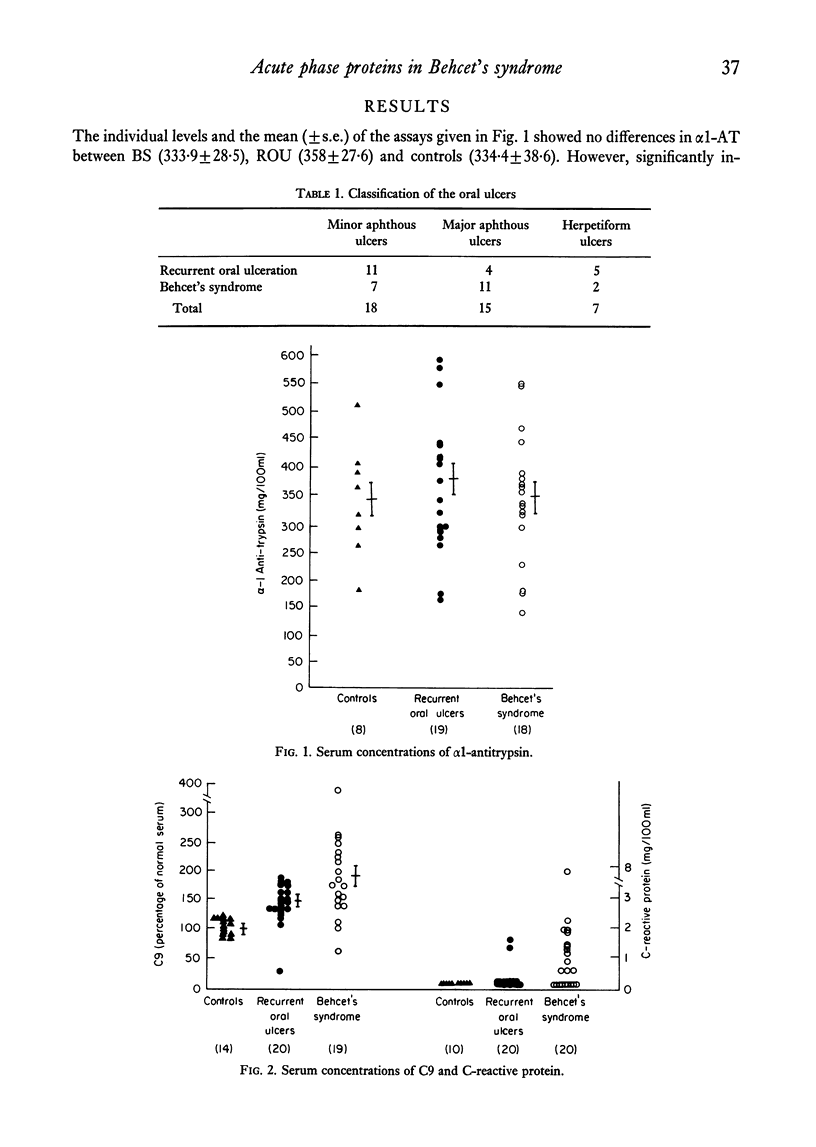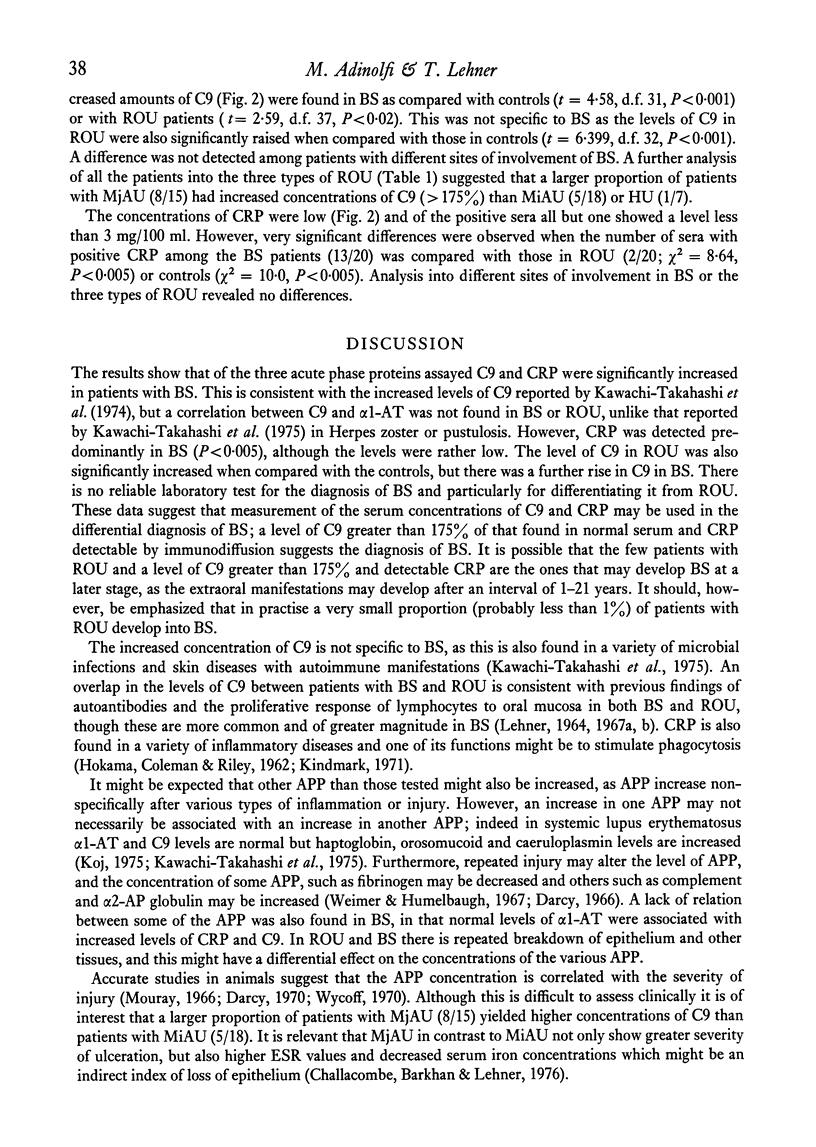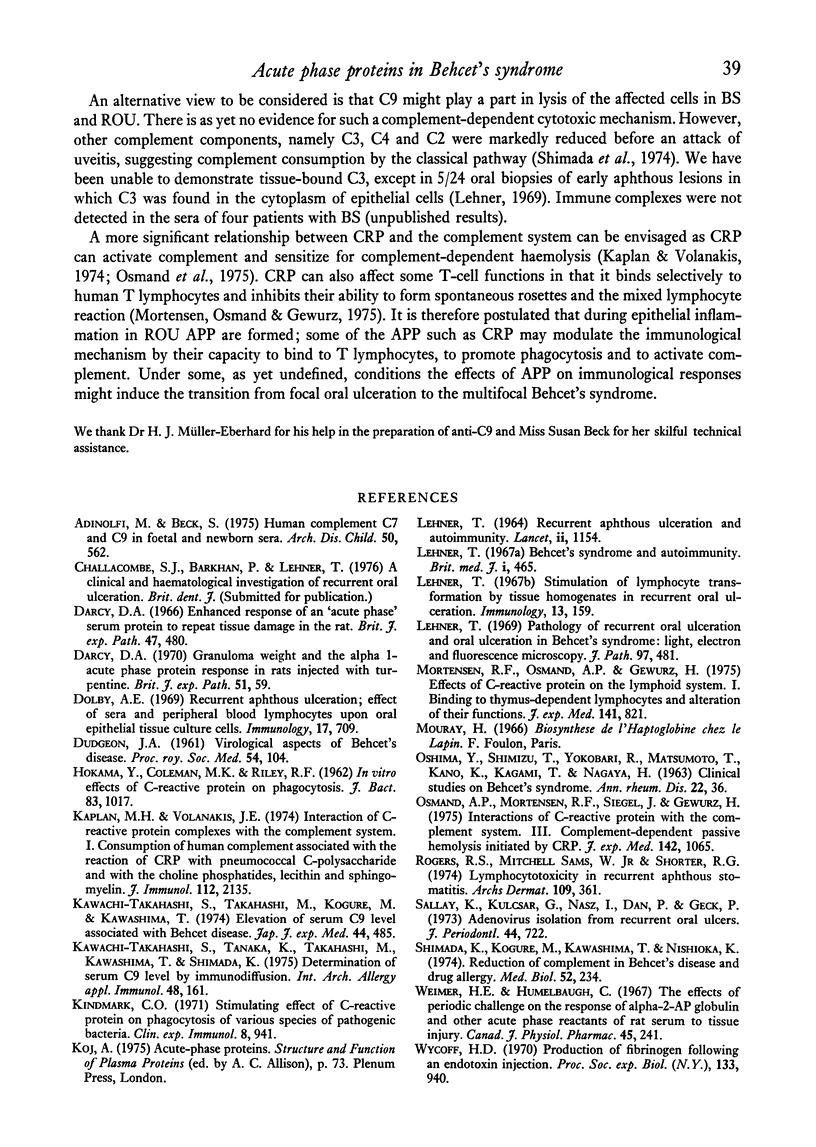Abstract
Estimation of the concentration of C9, C-reactive protein (CRP) and alpha1-antitrypsin in forty sera from patients with Behcet's syndrome and recurrent oral ulcers showed significantly increased amounts of C9 and CRP in Behcet's syndrome. The concentration of C9 was also significantly raised in recurrent oral ulceration, though to a lesser extent than in Behcet's syndrome. The assay C9 and CRP might be useful in the differential diagnosis of Behcet's syndrome, especially from recurrent oral ulcers. It is suggested that during epithelial inflammation in recurrent oral ulcers some of the acute phase proteins are increased and in some patients these may modulate the immunological mechanism in such a way as to induce a transition from focal oral ulceration to the multifocal Behcet's syndrome.
Full text
PDF



Selected References
These references are in PubMed. This may not be the complete list of references from this article.
- Adinolfi M., Beck S. E. Human complement C7 and C9 in fetal and newborn sera. Arch Dis Child. 1975 Jul;50(7):562–564. doi: 10.1136/adc.50.7.562. [DOI] [PMC free article] [PubMed] [Google Scholar]
- DUDGEON J. A. Virological aspects of Behcet's disease. Proc R Soc Med. 1961 Feb;54:104–106. [PMC free article] [PubMed] [Google Scholar]
- Darcy D. A. Enhanced response of an "acute phase" serum protein to repeated tissue damage in the rat. Br J Exp Pathol. 1966 Oct;47(5):480–487. [PMC free article] [PubMed] [Google Scholar]
- Darcy D. A. Granuloma weight and the alpha 1-acute phase protein response in rats injected with turpentine. Br J Exp Pathol. 1970 Feb;51(1):59–72. [PMC free article] [PubMed] [Google Scholar]
- Dolby A. E. Recurrent aphthous ulceration. Effect of sera and peripheral blood lymphocytes upon oral epithelial tissue culture cells. Immunology. 1969 Nov;17(5):709–714. [PMC free article] [PubMed] [Google Scholar]
- HOKAMA Y., COLEMAN M. K., RILEY R. F. In vitro effects of C-reactive protein on phagocytosis. J Bacteriol. 1962 May;83:1017–1024. doi: 10.1128/jb.83.5.1017-1024.1962. [DOI] [PMC free article] [PubMed] [Google Scholar]
- Kaplan M. H., Volanakis J. E. Interaction of C-reactive protein complexes with the complement system. I. Consumption of human complement associated with the reaction of C-reactive protein with pneumococcal C-polysaccharide and with the choline phosphatides, lecithin and sphingomyelin. J Immunol. 1974 Jun;112(6):2135–2147. [PubMed] [Google Scholar]
- Kawachi-Takahashi S., Tanaka K., Takahashi M., Kawashima T., Shimada K. Determination of serum C9 level by immunodiffusion. Elevation in patients with infectious or allergic skin diseases. Int Arch Allergy Appl Immunol. 1975;48(2):161–170. doi: 10.1159/000231302. [DOI] [PubMed] [Google Scholar]
- Kindmark C. O. Stimulating effect of C-reactive protein on phagocytosis of various species of pathogenic bacteria. Clin Exp Immunol. 1971 Jun;8(6):941–948. [PMC free article] [PubMed] [Google Scholar]
- LEHNER T. RECURRENT APHTHOUS ULCERATION AND AUTOIMMUNITY. Lancet. 1964 Nov 28;2(7370):1154–1155. doi: 10.1016/s0140-6736(64)92673-x. [DOI] [PubMed] [Google Scholar]
- Lehner T. Behçet's syndrome and autoimmunity. Br Med J. 1967 Feb 25;1(5538):465–467. doi: 10.1136/bmj.1.5538.465. [DOI] [PMC free article] [PubMed] [Google Scholar]
- Lehner T. Pathology of recurrent oral ulceration and oral ulceration in Behcet's syndrome: light, electron and fluorescence microscopy. J Pathol. 1969 Mar;97(3):481–494. doi: 10.1002/path.1710970307. [DOI] [PubMed] [Google Scholar]
- Lehner T. Stimulation of lymphocyte transformation by tissue homogenates in recurrent oral ulceration. Immunology. 1967 Aug;13(2):159–166. [PMC free article] [PubMed] [Google Scholar]
- Mortensen R. F., Osmand A. P., Gewurz H. Effects on C-reactive protein on the lymphoid system. I. Binding to thymus-dependent lymphocytes and alteration of their functions. J Exp Med. 1975 Apr 1;141(4):821–839. [PMC free article] [PubMed] [Google Scholar]
- Oshima Y., Shimizu T., Yokohari R., Matsumoto T., Kano K., Kagami T., Nagaya H. Clinical Studies on Behçet's Syndrome. Ann Rheum Dis. 1963 Jan;22(1):36–45. doi: 10.1136/ard.22.1.36. [DOI] [PMC free article] [PubMed] [Google Scholar]
- Rogers R. S., 3rd, Sams W. M., Jr, Shorter R. G. Lymphocytotoxicity in recurrent aphthous stomatitis. Lymphocytotoxicity for oral epithelial cells in recurrent aphthous stomatitis and Bechet syndrome. Arch Dermatol. 1974 Mar;109(3):361–363. [PubMed] [Google Scholar]
- Shimada K., Kogure M., Kawashima T., Nishioka K. Reduction of complement in Behçet's disease and drug allergy. Med Biol. 1974 Aug;52(4):234–239. [PubMed] [Google Scholar]
- Weimer H. E., Humelbaugh C. The effects of periodic challenge on the response of alpha-2-AP globulin and other acute-phase reactants of rat serum to tissue injury. Can J Physiol Pharmacol. 1967 Mar;45(2):241–247. doi: 10.1139/y67-027. [DOI] [PubMed] [Google Scholar]
- Wycoff H. D. Production of fibrinogen following an endotoxin injection. Proc Soc Exp Biol Med. 1970 Mar;133(3):940–943. doi: 10.3181/00379727-133-34599. [DOI] [PubMed] [Google Scholar]


